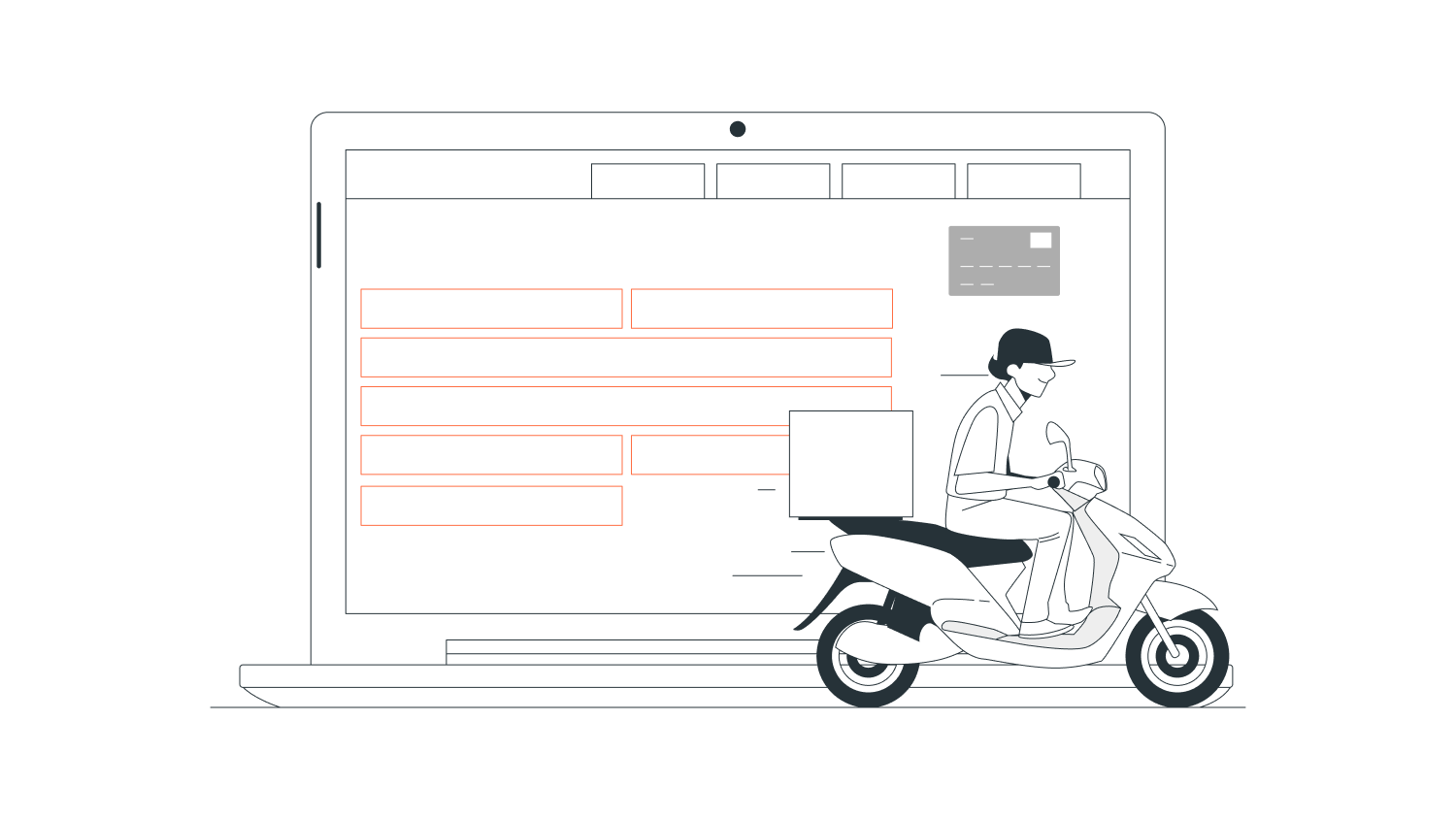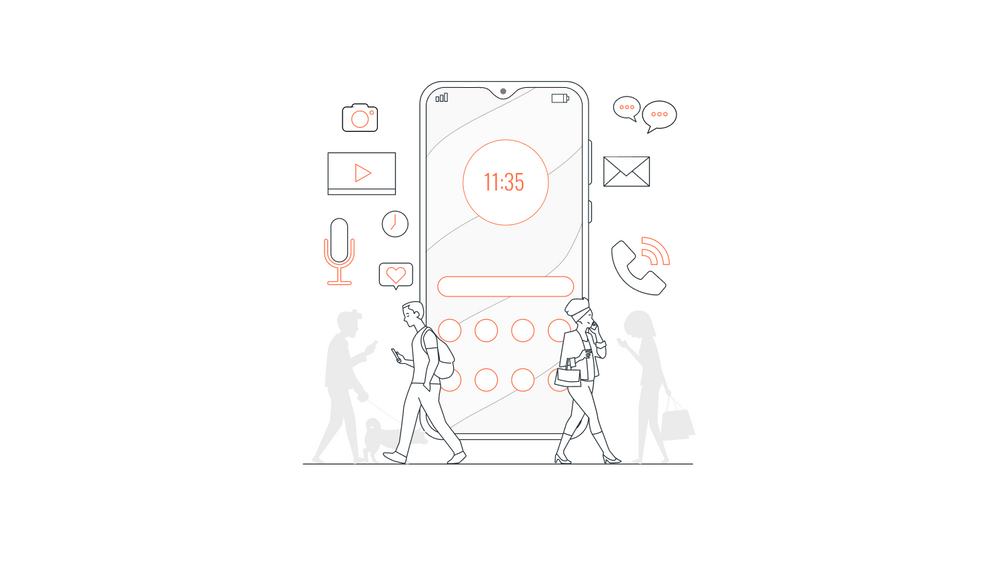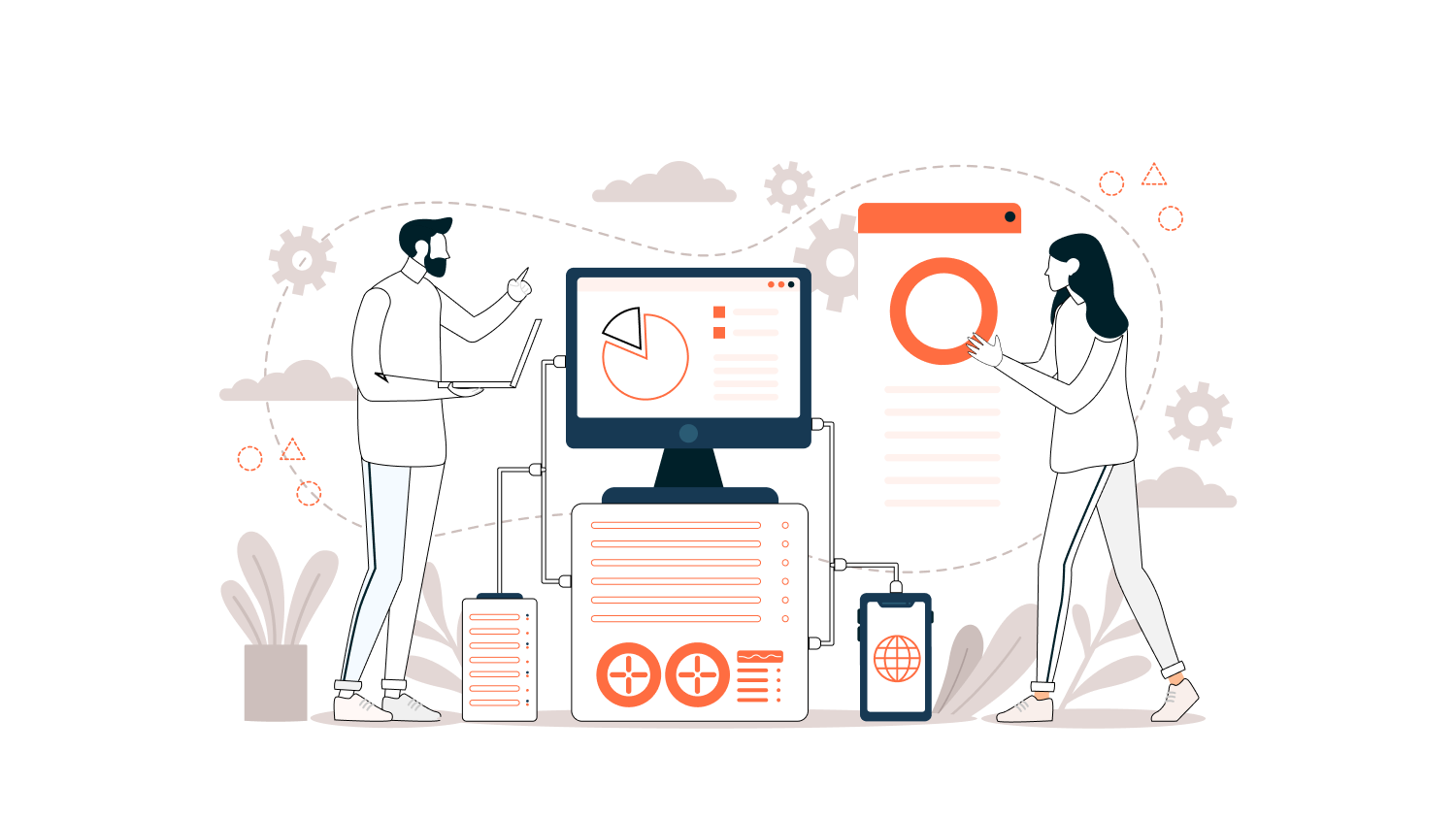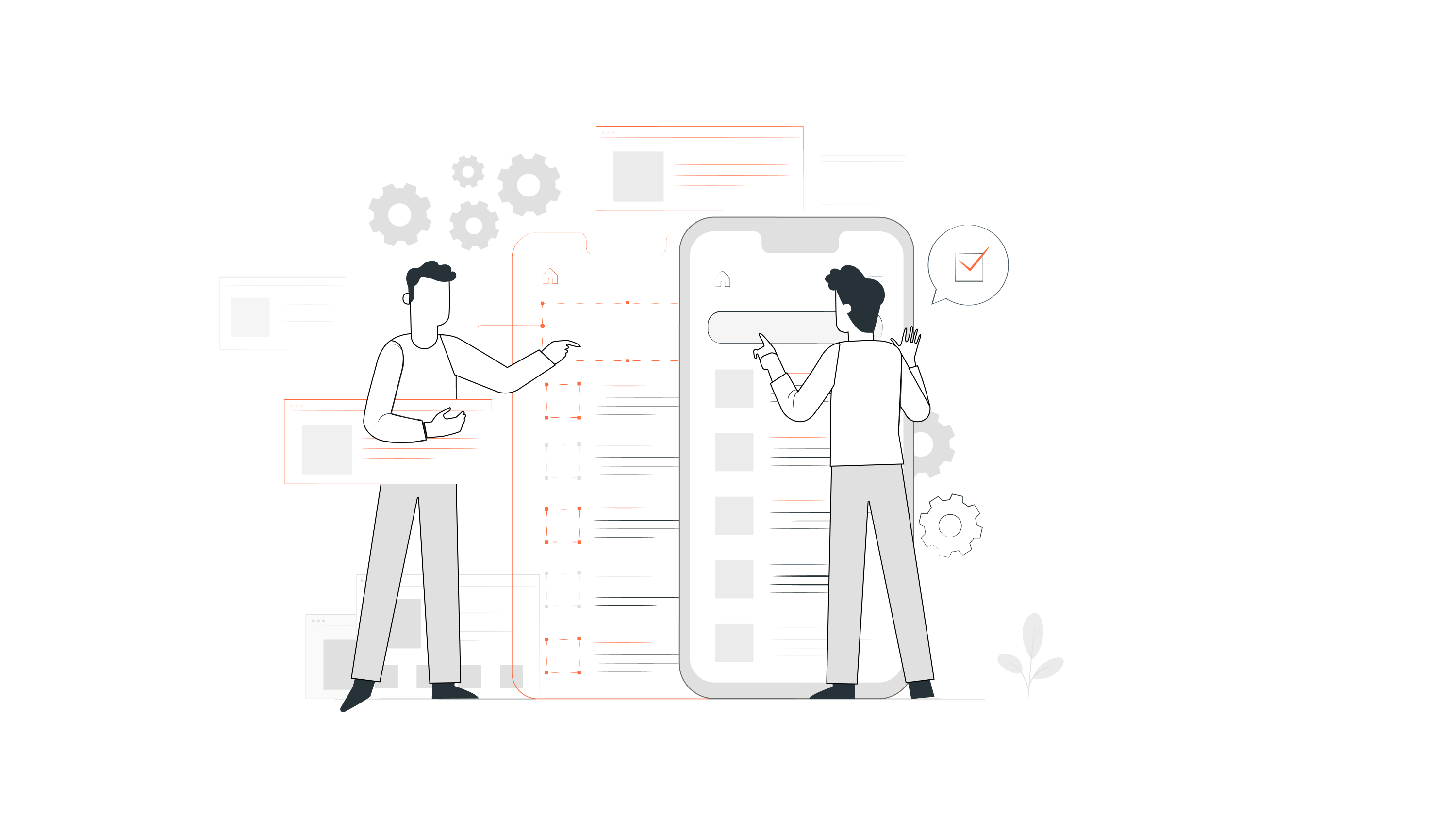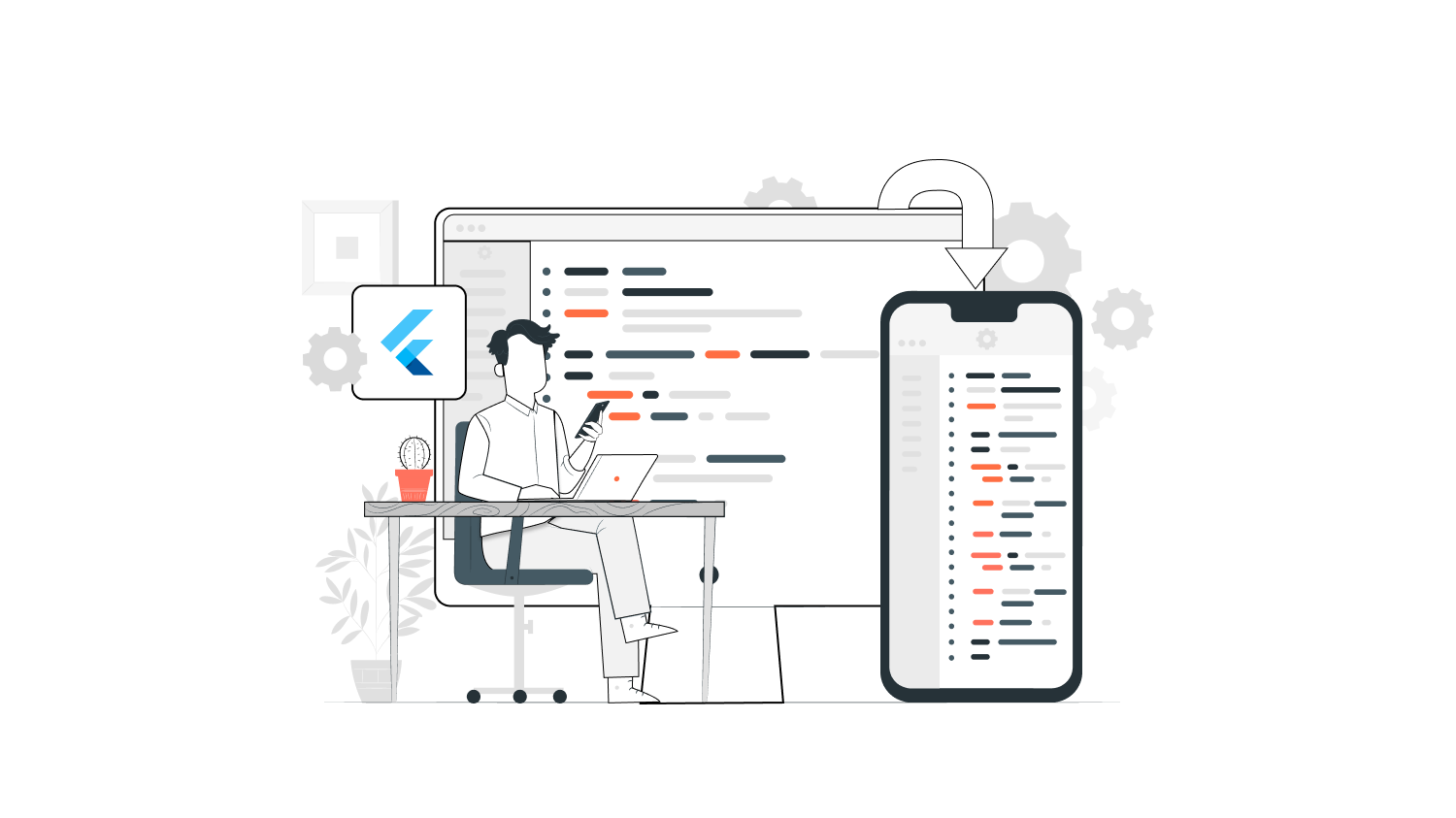Research shows that the international courier delivery industry has the opportunity to hit an estimate of more than $400 billion.
People value their time the most, and on-demand delivery apps help them save a lot of time.
For example, people relied on courier delivery apps to deliver essential products to their homes during the pandemic.
Everything we buy – from delicious food to the latest gadgets – reach our hands through a delivery service. Courier delivery apps help us purchase or send products without stepping out of our homes. So, developing an on-demand courier delivery app will be a great business opportunity.
In this blog, you will learn the practical steps to build an on-demand courier delivery app from scratch.
Let’s get started.
Types of Courier Delivery App
To build a successful on-demand courier delivery app, you need to understand the different types of courier delivery apps and how they operate.
A courier delivery app can operate at three levels:
- Business to Business (B2B)
B2B connects one business to another business. The primary purpose will be restocking goods from one large scale business to a retail business.
The retail shops can restock products according to their convenience by booking a service with B2B delivery services.
- Business to Customer (B2C)
B2C helps in trade between a business to a customer. When we place an order online or offline, B2C delivers the selected product to the specified customer from the business place.
- Customer to Customer (C2C)
C2C helps connect one customer to other customers at different locations. Through C2C courier service, the customer feels safe to transit their packages.
C2C courier app lets customers book a package from their application. The booked package will be picked up and transited by C2C courier service and delivered to the customer on the receiver end.
Now,
Take a look at the major types of on-demand courier apps based on their business model:
-
-
- Postal and courier application
- Package tracking apps
- Branded delivery and integrated services
- Uber-like apps for parcel delivery
-
Postal and Courier Application
Postal and courier service connects all three levels (B2B, B2C, C2C)of delivery service.
Here, you can book a package with the help of an app. The sender will be provided with a package id. The receiver will also get the details to track the package until it’s delivered.
Examples of postal and courier applications are growthFedEx, Blue dart, DPD.
Did you know?
FedEx even has a separate app for one-day delivery services.
This model needs more than one app for handling all the services between the customer, courier delivery agent and the company.
Package Tracking Apps
All the data from different carriers will be added and stored in one place in package tracking apps, along with a specified tracking ID. The tracking ID will be unique for every package.
With the help of the tracking ID and the push notification feature, you can track the package and keep yourself updated about the delivery.
The package tracking apps usually notify the sender and the receiver about the package’s status through a single app.
Deliveries and 17Track are suitable examples of this type of app.
Branded Delivery and Integrated Services
Many online stores have the feature to track the orders on their website or app. It will provide standard updates on despatch, shipping, live status, and estimated delivery date.
But for small local store owners, it will cost a lot to develop a delivery tracking app. In this case, they rely on third-party courier apps. These third-party apps are called branded delivery and integrated services.
Uber-like Apps for Parcel Delivery
Customers can request a service from a business place on Uber-like on-demand apps. When the order is requested, the delivery agent will complete it by picking it up from the business place to the customer.
A simple example will be ordering food from your favourite restaurant. The restaurant will fulfil your order through a delivery agent.
Uber-like apps are not only limited to food delivery and ride-hailing; it also covers most enterprises available like medical supplies, groceries, massage, plumbing and more.
Some examples of this kind of courier delivery app are:
-
-
- Roadie
- GrubHub
- Zomato
- Deliveroo
- Postmates and more.
-
8 Steps to Build an On-Demand Courier Delivery App
1. Idea validation and research
2. Hire a well-experienced team
3. Prioritise and categorise features
4. Create an MVP
5. Learn, iterate, evolve
6. Testing
7. Post-launch actions
8. Maintenance
Idea Validation and Research
In the first step, you have to select the business model for your app. You have to validate the idea to understand whether your customers need the solution.
You can validate your idea by answering these questions:
-
-
- Why a courier delivery app?
- How is receptive is the market?
- What is the demand for the services?
- What pain point does your app solve?
-
After selecting a suitable business model, you can validate your idea. You need to do extensive research on different aspects.
Get an idea about different types of business models and choose the one that satisfies your business needs.
With the help of proper market research, you will be able to understand:
-
-
- Your target audience
- Demography
- The locations you serve
- Your competitors and what they lack
- The vehicles you need to use for delivery
- Average parcel size and cost per package
- Commission fees for delivery services
- The range of products you deliver
-
Hire a Well-Experienced Team
You need to hire skilled app developers to develop your courier delivery app on time.
There are two ways to build your app:
-
-
- Hire a proficient team of designers, software developers, testers, quality analysts to work on your project.
- Outsource your app development project to a reputed product development company.
-
Read: 7 Vital Steps to Finding a Trustworthy Partner to Outsource Web Development
Unlike hiring a team, outsourcing will be a flexible option for small businesses or startups since it helps focus on other essential aspects of your business, like branding and marketing, without worrying much about the app development.
You will only need to sit in occasional scrum calls with the outsourcing company to manage your app development project. In addition, outsourcing comes handy even if you don’t have a technical background.
Here are some additional benefits of outsourcing your app development project.
-
-
- Outsourcing is cost and time effective
- It gives access to a pool of talents
- Reduces project development risks
- Increases operational efficiency of your core team
- End to end support
- Timely delivery
-
Read more: 10 Reasons Why You Should Outsource Your Mobile App Development
Prioritise and Categorise Features
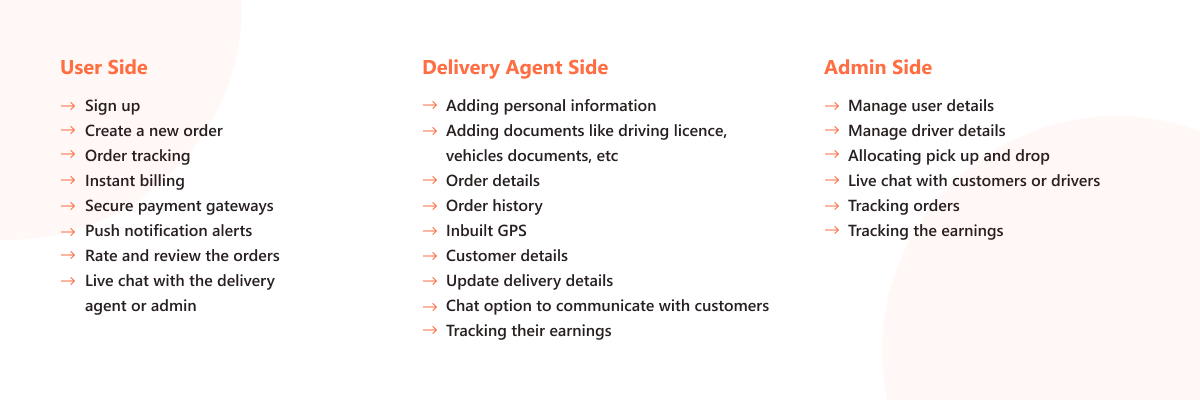
Some courier delivery services need more than one app to operate smoothly. There should be an app for the users, the courier delivery agent and the admin.
You have to be thoughtful while selecting the features for each app. Let’s look at the user side features of a courier delivery app.
User side features
When a customer downloads your app for the first time, you need to give the customer two options:
-
-
- Be a guest user
- Sign up as a user
-
You can add bonus points or promo coupons to get more users to sign up.
After the signup, you should need features like:
-
-
- Creating a new order
- Order tracking
- Instant billing
- Secure payment gateways
- Push notification alerts
- Rate and review the orders
- Live chat with the delivery agent or admin
-
It is crucial to have a seamless, user-friendly UI/UX design to ensure frictionless onboarding and placement of orders. To make your app successful in the long run, you need to ensure flawless execution of your mobile application.
Read and understand the top 9 mobile usability issues and solutions to ensure a seamless execution of your app.
Delivery agent side features
The agent side should have the following features for a hassle-free experience.
-
-
- Option to add personal information
- Option to upload documents like driving licence, vehicles documents, etc.
- Order details tab
- Order history tab
- Inbuilt GPS
- Customer details tab
- Realtime delivery update
- Chat option to communicate with customers
- Earnings tracker
-
It is essential to have a flawless user experience on the driver side to avoid any kind of friction or roadblocks while delivering the packages.
Admin side features
The admin side plays a significant role in allocating the pickup and delivery to the driver side and the customer. Admin side is also responsible for handling emergencies like a mix up of packages or any other failed deliveries.
Features for the admin side include:
-
-
- User details tab
- Option to manage drivers
- Option to assign pickup and drop
- Live chat option with customers or drivers
- Order tracking tab
- Earning tracker tab
-
Create an MVP
After narrowing it down to the essential features of your courier delivery app, you can develop a Minimum viable product (MVP).
MVP is a basic version of your app with minimum features to provide the required solution. The MVP doesn’t have any fancy features. It just serves the purpose.
You can release the MVP to the mobile platforms – App Store, Play Store and bag some early adopters. You can validate your app idea and revamp the features according to customer feedback with an MVP.
Designing an MVP lets you gain traction and easily attract investors to your project. Also, it provides data and analytical reports for your product validation, which is crucial while developing your full-fledged app.
Read: A Beginner’s Guide to MVP Software Development: Benefits, Challenges, Examples, and more
Learn, Iterate, Evolve
As a startup founder, your goal should be to make your MVP available to early adopters as soon as possible. Once your MVP goes live, collect all the feedback and evaluate each of them. Improve your user experience in line with the customer feedback.
It would be a great idea to note down your MVP’s feedback and modify your full-fledged app accordingly.
Remember: Many great apps were once an MVP. So go slowly in the right direction rather than going fast in the wrong direction.
Testing
After developing your courier delivery app, you must pass the testing stage. In this stage, you will test each aspect of your app to ensure it functions properly.
The crucial tests required for an app are:
-
-
- Functional testing
- Speed testing
- UI/UX testing
- Security checks
- Admin testing
- Performance testing
- Compatibility testing
-
Post-Launch Actions
After launching the app, you must concentrate on promoting your services to your target customers. You can provide promo codes, coupons, referral codes to attract more initial customers.
Every time you get feedback, try to respond to them and quickly act on the issues to build more trust in your app.
Maintenance
Post-launch maintenance is a crucial part of your app’s success. There are front end, back end developments, user interfaces and a large amount of database id stored in an app.
There are many possibilities of encountering a bug or updating the app to enhance performance, and a dedicated maintenance team is necessary to handle these activities.
Different types of mobile app maintenance are:
-
-
- Corrective maintenance
- Emergency maintenance
- Perfective maintenance
- Adaptive maintenance
- Preventive maintenance
-
You can outsource your app maintenance to a reliable product development company for better results.
Some benefits of post-launch app maintenance are as follows:
-
-
- Enhances mobile security to avoid cyber threats
- Improves user experience
- Quick identification and fixing of bugs
- Overall business growth
- Updation of the app to make it compatible with the latest version of the operating systems
-
Must-have Features for an Outstanding Courier Delivery App
We have discussed some basic features in the earlier part of this blog. Your courier delivery app needs some unique features to stand out in the crowd.
1. AI chatbots
Automated chatbots are everywhere, and having them in your courier delivery app will be a great advantage. For example, your user doesn’t have to wait for your customer service executives just to know the delivery date. AI chatbots can easily fetch the tracking information and share it with the users.
Read and understand how you can create an app using AI/ML.
2. Calendar
An in-built calendar on your app lets users choose the date and time of the delivery according to their convenience.
3. Real-time tracking
Real-time tracking will be one of the essential features for every courier delivery app. With this feature, customers get all the information and the exact location of their packages.
This feature results in more customer satisfaction and trust. Plus, real-time tracking helps the admin allocate the nearest delivery partner to handle a package.
4. Multiple payment options
Providing multiple payment options will give you an edge over your competitors. Try to offer different payment options like:
-
-
- Debit card
- Credit card
- Wallet
- COD
-
5. Rewards and offers
With the help of Artificial Intelligence, you can provide personalised offers to your customers.
Customised offers will make users feel more special. Many courier delivery apps have integrated AI for creating personalised offers to bag more users.
6. Enhanced customer support
Treat your customers like a king. They will never forget you! To succeed in the long run, you have to provide the best customer service.
Valuing your customer’s time is crucial; every customer wants to get their issues sorted in a blink of an eye! So, address customers’ problems and tackle them as soon as possible.
Don’t forget to concentrate on social media, many people share their queries on social media for quick response.
This way, you can level up your customer support game and attract more users to your app.
Also Read: Top 10 Advantages of Artificial Intelligence in Mobile App Development
Cost of Developing a Courier Delivery App
The cost of developing an on demand courier delivery app depends on the following factors:
-
-
- The features needed of your courier delivery app.
- The type of product you want to develop – an MVP or a full-fledged app.
- Post-launch maintenance and support.
- The number of apps/backends you need to create. Sometimes you may require separate apps for customers and admins.
-
ALSO READ:
On Demand App Trends & Statistics to Know in 2022
Conclusion
Building an app is only half the battle. To bag more users consistently, you need to offer top-notch customer support and a seamless user experience. The key is to tackle the delivery-related issues of your customers as fast as possible.
Outsourcing your app development project to a reliable tech partner helps you build your app on time with all the features you need.
So, if you are ready to start your product development, take a look at the things you need to keep in mind before you hire a technical support team and reach out to us!
